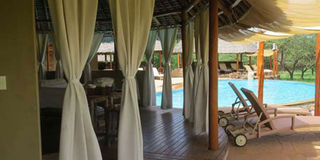In search of the red elephants of Tsavo

Kenbali Spa at Severin Safari Camp in Tsavo West National Park. PHOTO | RUPI MANGAT
What you need to know:
- The usually dry Tsavo West is now lush after the rains. Driving slowly, we pass tall plump baobabs which stand sentinel with fruit pods hanging like bats from the branches. We crisscross the land, searching for the red elephants of Tsavo, named after the rich red earth.
- The dark volcanic flow of Shetani lava flow is etched on the earth from a dark volcanic cone amongst the cluster in the amazing Chyulu Hills.
When I read about the 10 collared elephants of Tsavo, I had to go to the national park to see them and I crossed my fingers hoping to see them crossing under the newly constructed Standard Gauge Railway (SGR) running through one of the last great frontiers of wild country – the mighty Tsavo.
Everything looks doable on tiny maps, but the reality on the ground driving in through the Tsavo West gate at Mtito Andei was very different – picture this: Tsavo West National Park is 9,065 square kilometres while Tsavo East is 13,747 square kilometres. Looking for the world’s largest land mammal between the two parks is like looking for a needle in a haystack.
The usually dry Tsavo West is now lush after the rains. Driving slowly, we pass tall plump baobabs which stand sentinel with fruit pods hanging like bats from the branches. We crisscross the land, searching for the red elephants of Tsavo, named after the rich red earth. The dark volcanic flow of Shetani lava flow is etched on the earth from a dark volcanic cone amongst the cluster in the amazing Chyulu Hills. Still, we find no elephants, but we come across towers of giraffes and a few dikdiks.
HEART OF TSAVO
The Five Sisters – the volcanic hills in a row – make a pretty picture enroute to the Poachers Outlook for a surreal 360-degree panorama of Tsavo. Way below are more giraffes and a bateleur eagle soaring in the freedom of the skies. Still no elephants.
Undeterred, we drive down through the acacia grove. And then a magical sight! A herd of about 100 elands, the world’s largest antelope, browse in the acacia forest. A silent command triggers one to cross the road in a slow trot and then that spectacular jump: vertically up and over the edge of the steep shoulder of the road. The rest follow in a show of graceful high leaps like a ballet in the wild.
A few metres away, a greater kudu with its spiralling horns and white streaks on brown hide enjoys the green lush scrub.
We’re well into the heart of Tsavo. We stop at the clear water springs of Mzima, where water percolates through the porous lava rocks of the Chyulu Hills. Without these amazing 100-kilometer stretch of hills visible on the Nairobi-Mombasa highway, there would be no Mzima Springs and there would be little fresh water in Mombasa, for the springs supply an incredible 250 million litres of fresh water a day.
It is late afternoon now. Troops of vervet monkeys and curious Sykes monkeys climb up the trees nibbling on dates and figs. In the underwater observatory, we watch two worlds simultaneously – the water world with barbels (fish) swimming at eye-level and the world above with a colourful malachite kingfisher flitting about. It’s magical!
At the upper pool, hippos snort – the happiest hippos in the world. The river horses as the ancient Greeks called them, keep the springs alive – their dung fertilises the soils while their stomping around in the shallow pools keep the water aerated and the soils porous.
But still no elephants.
The day is drawing to a close. We give it one last chance and drive across Kitani River and over the bridge of Tsavo River. Both rivers are in full spate and are lined with one of the largest groves of doum palms.
We still haven’t seen elephants.
By now we’re deep in Tsavo West in the area of Kitani. We check in at the luxurious Severin Safari Camp where I relish a super-relaxing aromatic massage at the signature Kenbali Spa at sunset. It’s time to call it a day in Tsavo and wait for daybreak.
*****
Tsavo tidbits
Tsavo has 12, 000 elephants, but their future is in question given the poaching menace and the new 483-kilometre train route linking Nairobi to Mombasa. However, the impact of the new railway slicing through Tsavo, and its effect on migratory elephants and other wildlife, remains to be seen. The elephants are collared to track their movements and to make their crossing between parks safer. Their migration is one of the last big game migrations in Africa.
*****
Accommodation
When at Tsavo, you can stay at Severin Safari Camp (www.severin-hotels.com) if you want understated luxury. There’s free wi-fi everywhere but no cell phone service! Don’t forget to treat yourself to some pampering at Kenbali Spa.




